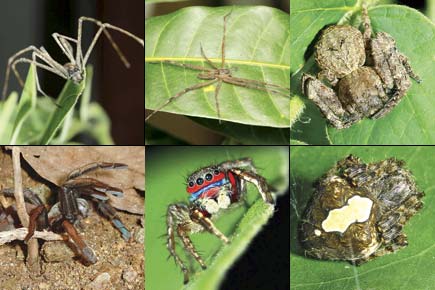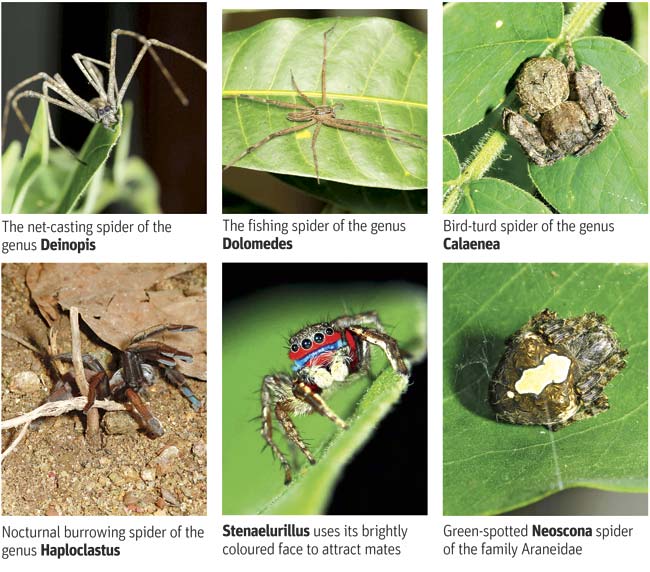New spider species were discovered at Parambikulam Tiger Reserve (PTR) in Kerala over the course of a four weeks long study commissioned by the Kerala forest department

Arachnophobia just got scarier by eight new species, discovered recently at the Parambikulam Tiger Reserve (PTR) in Kerala by Dr Sudhikumar A V, research supervisor and assistant professor, Department of Zoology, Christ College, Irinjalakuda, during a study embarked upon following a request from the Kerala forest department.

ADVERTISEMENT
“PTR in the Western Ghats is a biodiversity hotspot of the world. Our forest department is planning to explore and document the virgin biodiversity there. The study was conducted over four weeks, and started on October 8. We explored different habitats like evergreen forests, mountaintop grasslands, moist deciduous forests and small shola forests. This study resulted in the finding of eight new species of spiders,” Dr Sudhikumar said.
He added that although many new species of fauna and flora are reported in numerous studies, the biodiversity of the region is a very less explored one Researchers had to brave deadly snakes, gaurs and bears that visited their campsite routinely. Sometimes, they awoke in the middle of the night to the roar of tigers.
New families of crawlies
Of the discoveries, Sudhikumar said, “A net-casting spider of Deinopis genus of family Deinopidae is the most interesting. This twig-like spider is well-camouflaged, and spins its web amid the first four legs, waiting patiently for the prey. When the prey comes close, it casts its sticky web on the prey’s body, entangling it. It is very difficult to spot in a field.
“Then there is the fishing spider of the genus Dolomedes under the family Pisauridae that lives in the vegetation of nearby water bodies, and can catch small fish when the time is suitable. It is capable of living underwater for a few minutes.” The spider of the genus Calaenea usually holds its legs very close to its body and remains immobile, resembling a bird dropping. This aggressive, dark-looking creature ambushes its prey. Species of this genus have been reported from Australian region.
A new species of the genus Haploclastus is an inhabitant of the evergreen forest. It usually lives in potholes in the ground. This is a nocturnal spider and very difficult to catch because of its hiding behaviour. Another new discovery is of the genus Stenaelurillus. It is peculiar for its contrasting red-and-blue line in the forehead region. This spider exhibits the contrasting colours during a nuptial dance to attract its female partner.
Other species of this genus all are darker. Green-spotted Neoscona spider of the family Araneidae, diamond-shaped Stenochilus of the family Stenochilidae, and yellow-spotted Hasarious of the family Salticidae also made a debut in the zoological sciences.
Our very own
Most of the 210 samples collected as part of the four-week study are endemic to the Ghats. Their faunistic analysis highlights that some species are showing similarities with their counterparts in the African region, while some others are near-identical with those in the Malayan region.
Researchers feel that studies based on the use of DNA markers are required to reveal the truth of evolutionary changes in the spider fauna of the Indian subcontinent. “We are also expecting international collaboration for this expensive study,” Dr Sudhikumar told mid-day.
The study was carried out with the help of research scholars Nafin K S, Sudhin P P, Sumesh N V, Ajay P Krishna, Misvar Ali and Jimmy Paul. This is the first time that the diversity of spiders is being researched by the Kerala forest department. The researchers plan to publish their findings in the Journal of Arachnology, a scientific journal of the American Arachnological Society.
Preserve them
Many researchers feel that there is a need for sterner laws to curb illegal sale and purchase of arachnids online on international websites. “It is really good that researchers are discovering new species of spiders and tarantulas. There is a huge demand for them in the international market.
There are many websites involved in the pet trade of these creatures, and in order to stop such illegal dealings, the government should come up with stricter laws and regulations. Spiders should also get a protection status so these beautiful creatures don’t go out of the country,” a researcher said, requesting anonymity.
 Subscribe today by clicking the link and stay updated with the latest news!" Click here!
Subscribe today by clicking the link and stay updated with the latest news!" Click here!







